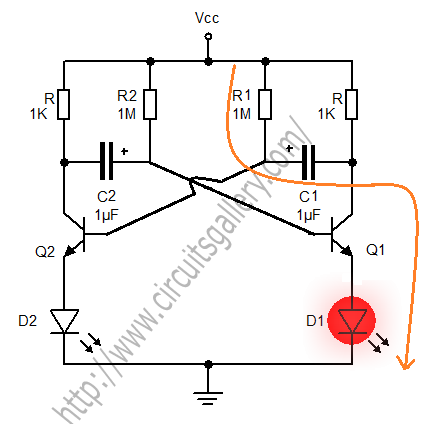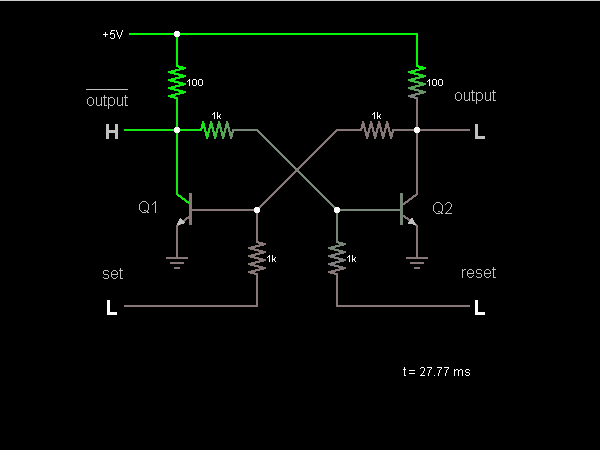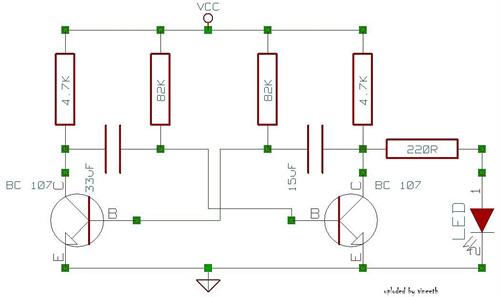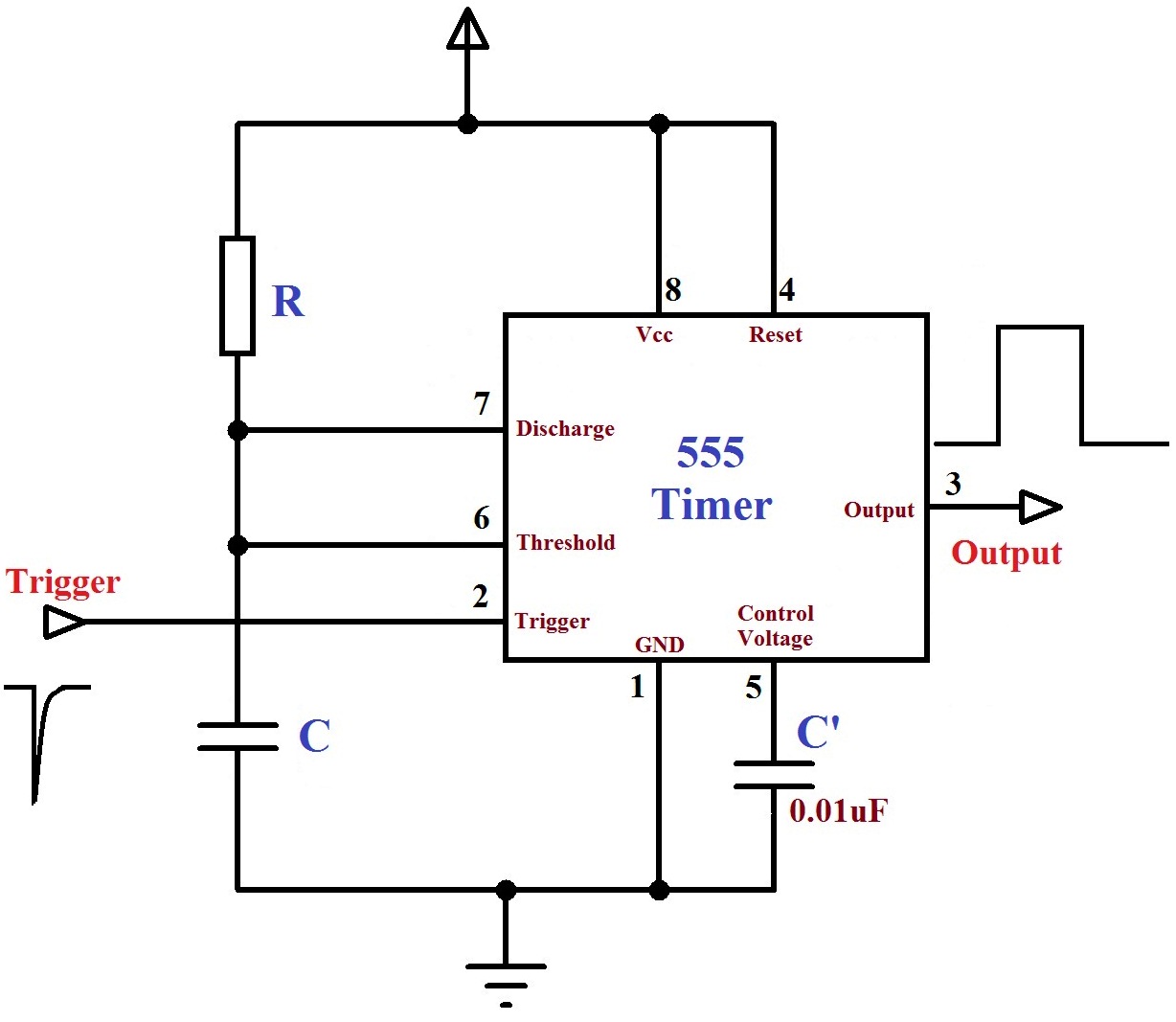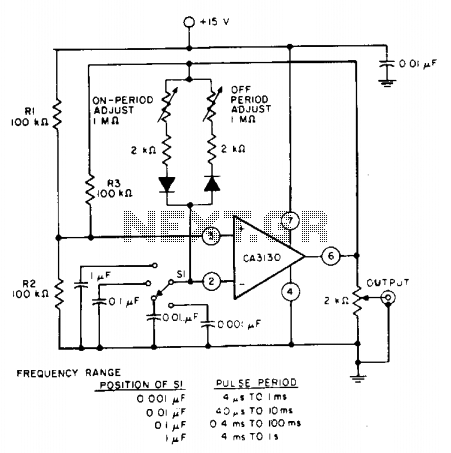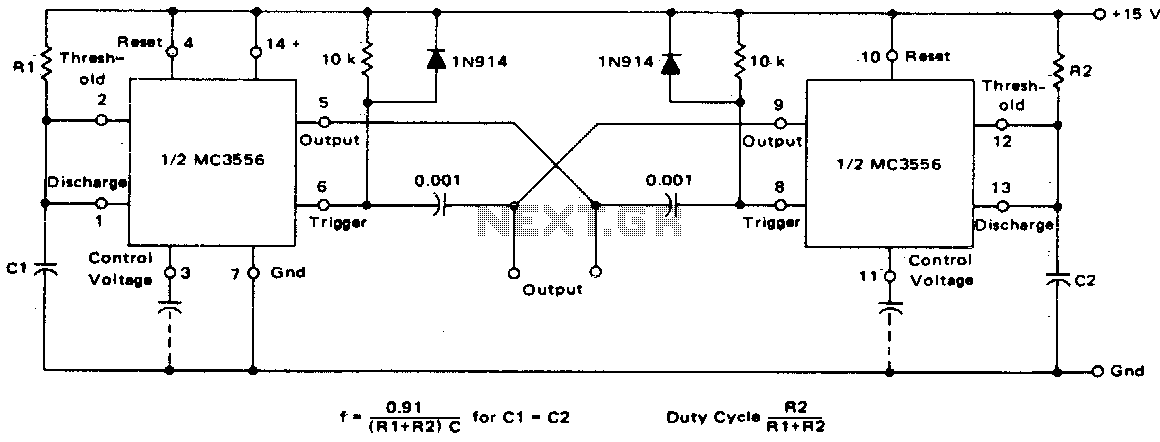
Multivibrator
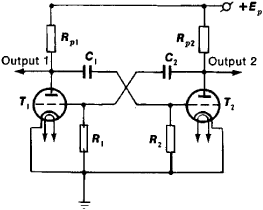
A relaxation oscillator utilizes two tubes, transistors, or other electronic devices, with the output of each connected to the input of the other through resistance-capacitance elements or other components to achieve in-phase feedback voltage. This electronic circuit employs positive feedback to cross-couple two devices, allowing for two distinct states, such as one device being ON and the other OFF. The states of the devices can be interchanged either by external pulses or by internal capacitance coupling. Transition times between states are typically very short compared to the ON and OFF periods, resulting in output waveforms that are essentially rectangular. Multivibrators can be classified as bistable, monostable, or astable. A bistable multivibrator, often called a flip-flop, has two stable states, each with one device ON and the other OFF, and the states can only be interchanged by applying external pulses. A monostable multivibrator, also known as a one-shot, has two states, with only one being stable. If triggered externally to the opposite state, it will return to the stable state after a time period typically controlled by a resistance-capacitance (RC) coupling circuit. An astable multivibrator has two states that are not stable, switching between them usually controlled by two RC coupling time constants. The astable circuit is a type of relaxation oscillator that generates periodic waveforms at a controllable rate. In bistable multivibrators, either of the two devices in a symmetrical circuit may conduct while the other does not until an external pulse is applied. This type of multivibrator is characterized by having two stable states. The original bistable multivibrator utilized vacuum tubes and was known as the Eccles-Jordan circuit, named after its inventors. It is also referred to as a flip-flop or binary circuit due to the two alternating output voltage levels. The junction field-effect transistor (JFET) circuit is a solid-state version of the Eccles-Jordan circuit. Its resistance networks between positive and negative supply voltages ensure that, with no current flowing to the drain of the first JFET, the voltage at the gate of the second JFET is slightly negative, zero, or at most slightly positive. This results in current flow in the drain circuit of the second JFET, causing a voltage drop across the drain load resistor, which in turn lowers the voltage at the gate of the first JFET, maintaining it in an OFF state while the second remains ON as long as the circuit is undisturbed. If a sharp negative pulse is applied to the gate of the ON transistor, its drain current decreases, causing its drain voltage to rise. A portion of this rise is transferred to the gate of the OFF transistor, allowing some drain current to flow. The resulting voltage drop in the drain, applied to the gate of the ON transistor, causes further rise in its drain voltage. This action exemplifies positive feedback, allowing for nearly instantaneous transfer of conduction from one device to the other. A reversal occurs each time a pulse is applied to the gate of the ON transistor. Pulses are typically applied to both transistors simultaneously, ensuring that whichever device is ON will be turned OFF. The capacitances between the gate of one transistor and the drain of the other enhance the high-frequency response of the voltage divider network by compensating for the input capacitances of the transistors, thus improving the speed of transition.
The described relaxation oscillator circuit can be utilized in various applications, including timers, frequency generators, and pulse-width modulation systems. The bistable multivibrator configuration allows for stable data storage and switching applications, making it suitable for digital memory elements. The monostable multivibrator can serve as a timing element, producing single output pulses of predetermined duration in response to triggering events. The astable multivibrator configuration is particularly useful for generating continuous square wave signals, which can be employed in clock generation for digital circuits.
In practical implementations, the choice of transistors or tubes affects the performance characteristics of the oscillator, including frequency stability, power consumption, and output signal integrity. Designers must carefully select component values for the resistors and capacitors in the feedback network to achieve the desired frequency and duty cycle for the output waveform. Additionally, the layout of the circuit on a printed circuit board (PCB) can influence the overall performance, with attention paid to minimizing parasitic capacitance and inductance.
Overall, the relaxation oscillator serves as a fundamental building block in electronic design, illustrating the principles of feedback and state control in circuit operation.A relaxation oscillator using two tubes, transistors, or other electron devices, with the output of each coupled to the input of the other through resistance-capacitance elements or other elements to obtain in-phase feedback voltage. A form of electronic circuit that employs positive feedback to cross-couple two devices so that two distinct states
are possible, for example, one device ON and the other device OFF, and in which the states of the two devices can be interchanged either by use of external pulses or by internal capacitance coupling. When the circuit is switched between states, transition times are normally very short compared to the ON and OFF periods.
Hence, the output waveforms are essentially rectangular in form. Multivibrators may be classified as bistable, monostable, or astable. A bistable multivibrator, often referred to as a flip-flop, has two possible stable states, each with one device ON and the other OFF, and the states of the two devices can be interchanged only by the application of external pulses. A monostable multivibrator, sometimes referred to as a one-shot, also has two possible states, only one of which is stable.
If it is forced to the opposite state by an externally applied trigger, it will recover to the stable state in a period of time usually controlled by a resistance-capacitance (RC) coupling circuit. An astable multivibrator has two possible states, neither of which is stable, and switches between the two states, usually controlled by two RC coupling time constants.
The astable circuit is one form of relaxation oscillator, which generates recurrent waveforms at a controllable rate. In bistable multivibrators, either of the two devices in a completely symmetrical circuit may remain conducting, with the other nonconducting, until the application of an external pulse.
Such a multivibrator is said to have two stable states. The original form of bistable multivibrator made use of vacuum tubes and was known as the Eccles-Jordan circuit, after its inventors. It was also called a flip-flop or binary circuit because of the two alternating output voltage levels.
The junction field-effect transistor (JFET) circuit (Fig. 1) is a solid-state version of the Eccles-Jordan circuit. Its resistance networks between positive and negative supply voltages are such that, with no current flowing to the drain of the first JFET, the voltage at the gate of the second is slightly negative, zero, or limited to, at most, a slightly positive value. The resultant current in the drain circuit of the second JFET causes a voltage drop across the drain load resistor; this drop in turn lowers the voltage at the gate of the first JFET to a sufficiently negative value to continue to reduce the drain current to zero.
This condition of the first device OFF and the second ON will be maintained as long as the circuit remains undisturbed. See Transistor If a sharp negative pulse is applied to the gate of the ON transistor, its drain current decreases and its drain voltage rises.
A fraction of this rise is applied to the gate of the OFF transistor, causing some drain current to flow. The resultant drop in drain voltage, transferred to the gate of the ON transistor, causes a further rise at its drain.
The action is thus one of positive feedback, with nearly instantaneous transfer of conduction from one device to the other. There is one such reversal each time a pulse is applied to the gate of the ON transistor. Normally pulses are applied to both transistors simultaneously so that whichever device is ON will be turned off by the action.
The capacitances between the gate of one transistor and the drain of the other play no role other than to improve the high-frequency response of the voltage divider network by compensating for the input capacitances of the transistors and thereby improving the speed of transition. A bipolar transistor counterpart of the JFET bistable mu 🔗 External reference
The described relaxation oscillator circuit can be utilized in various applications, including timers, frequency generators, and pulse-width modulation systems. The bistable multivibrator configuration allows for stable data storage and switching applications, making it suitable for digital memory elements. The monostable multivibrator can serve as a timing element, producing single output pulses of predetermined duration in response to triggering events. The astable multivibrator configuration is particularly useful for generating continuous square wave signals, which can be employed in clock generation for digital circuits.
In practical implementations, the choice of transistors or tubes affects the performance characteristics of the oscillator, including frequency stability, power consumption, and output signal integrity. Designers must carefully select component values for the resistors and capacitors in the feedback network to achieve the desired frequency and duty cycle for the output waveform. Additionally, the layout of the circuit on a printed circuit board (PCB) can influence the overall performance, with attention paid to minimizing parasitic capacitance and inductance.
Overall, the relaxation oscillator serves as a fundamental building block in electronic design, illustrating the principles of feedback and state control in circuit operation.A relaxation oscillator using two tubes, transistors, or other electron devices, with the output of each coupled to the input of the other through resistance-capacitance elements or other elements to obtain in-phase feedback voltage. A form of electronic circuit that employs positive feedback to cross-couple two devices so that two distinct states
are possible, for example, one device ON and the other device OFF, and in which the states of the two devices can be interchanged either by use of external pulses or by internal capacitance coupling. When the circuit is switched between states, transition times are normally very short compared to the ON and OFF periods.
Hence, the output waveforms are essentially rectangular in form. Multivibrators may be classified as bistable, monostable, or astable. A bistable multivibrator, often referred to as a flip-flop, has two possible stable states, each with one device ON and the other OFF, and the states of the two devices can be interchanged only by the application of external pulses. A monostable multivibrator, sometimes referred to as a one-shot, also has two possible states, only one of which is stable.
If it is forced to the opposite state by an externally applied trigger, it will recover to the stable state in a period of time usually controlled by a resistance-capacitance (RC) coupling circuit. An astable multivibrator has two possible states, neither of which is stable, and switches between the two states, usually controlled by two RC coupling time constants.
The astable circuit is one form of relaxation oscillator, which generates recurrent waveforms at a controllable rate. In bistable multivibrators, either of the two devices in a completely symmetrical circuit may remain conducting, with the other nonconducting, until the application of an external pulse.
Such a multivibrator is said to have two stable states. The original form of bistable multivibrator made use of vacuum tubes and was known as the Eccles-Jordan circuit, after its inventors. It was also called a flip-flop or binary circuit because of the two alternating output voltage levels.
The junction field-effect transistor (JFET) circuit (Fig. 1) is a solid-state version of the Eccles-Jordan circuit. Its resistance networks between positive and negative supply voltages are such that, with no current flowing to the drain of the first JFET, the voltage at the gate of the second is slightly negative, zero, or limited to, at most, a slightly positive value. The resultant current in the drain circuit of the second JFET causes a voltage drop across the drain load resistor; this drop in turn lowers the voltage at the gate of the first JFET to a sufficiently negative value to continue to reduce the drain current to zero.
This condition of the first device OFF and the second ON will be maintained as long as the circuit remains undisturbed. See Transistor If a sharp negative pulse is applied to the gate of the ON transistor, its drain current decreases and its drain voltage rises.
A fraction of this rise is applied to the gate of the OFF transistor, causing some drain current to flow. The resultant drop in drain voltage, transferred to the gate of the ON transistor, causes a further rise at its drain.
The action is thus one of positive feedback, with nearly instantaneous transfer of conduction from one device to the other. There is one such reversal each time a pulse is applied to the gate of the ON transistor. Normally pulses are applied to both transistors simultaneously so that whichever device is ON will be turned off by the action.
The capacitances between the gate of one transistor and the drain of the other play no role other than to improve the high-frequency response of the voltage divider network by compensating for the input capacitances of the transistors and thereby improving the speed of transition. A bipolar transistor counterpart of the JFET bistable mu 🔗 External reference
